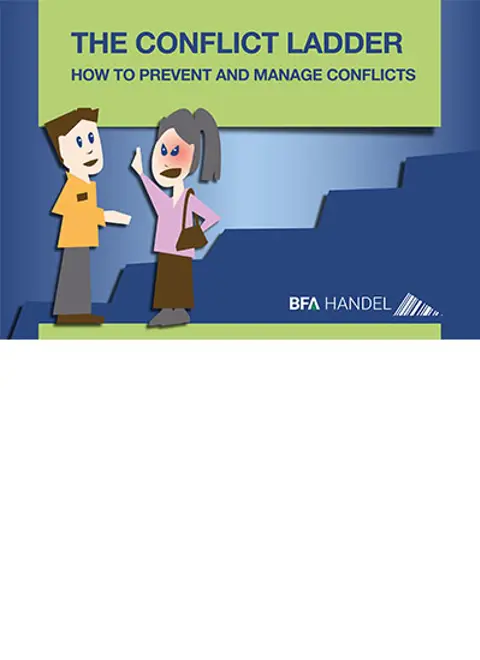The conflict ladder consists of five steps – or stages – and the conflict intensifies as you move up the ladder. It’s much easier to de-escalate the situation at the bottom steps, and much harder once the conflict has reached steps 4 or 5. It’s therefore important to identify a conflict early on.

The five steps of the conflict ladder
Typically, the customer will go through all five steps – or stages – but the individual stages may not be visible to you. The conflict may have escalated even before you meet the customer. For example, the customer may already have a prenotion that the shop won’t give her a refund, and she may therefore already be upset before entering the shop.
Step 1: Disagreement (the issue at hand). It begins as a disagreement about a specific matter or issue. If you and the customer can discuss the issue without becoming emotionally involved, you can avoid conflict. At this stage, the customer is okay about disagreeing with you.
- Here is what you can do: Avoid saying or doing anything to irritate or upset the customer, such as interrupting the customer or doing other things while you’re talking with the customer. Allow the customer time to explain, and show the customer that you’re listening and that you understand. Focus on the issue; that way you won’t get annoyed as easily.
Step 2: Blaming (the other person). The situation develops to a point where it’s no longer about the issue; it’s about the other person. Both parties become personal and blame the other for standing in the way of resolving the disagreement. At this stage, the customer will feel that you’re not listening and that you’re not trying to understand her situation.
- Here is what you can do: Be curious, ask questions, and let the customer describe her version of the situation. Show that you’re listening and that you understand. Remember that you don’t have to agree, you just have to respect and accept how the customer sees the situation. Avoid explaining the issue further, correcting misunderstandings the customer might have or giving your own version of the matter until you’re back at step 1.
Step 3: More problems. At this stage, the conflict escalates further and becomes bigger as more and more problems are included in the discussion. For example, the customer may recall stories about other customers who have experienced problems with the same shop or other annoying things about the shop, and, sometimes, the customer doesn’t say these things out loud.
- Here is what you can do: Avoid discussing the other problems the customer refers to. If you do, it will only complicate the situation and worsen the conflict. You shouldn’t ignore the other problems the customer mentions. Instead, you should convince the customer to focus on the issue at hand. For example, you can say that you will be happy to discuss the other problem afterwards, but that, for now, you would like to keep to the issue at hand.
Step 4: Open hostility. The situation is very uncomfortable now, and mean and unpleasant things are being said and done. The parties no longer see each other as human beings for better or worse; they no longer have any empathy for one another and react without any regard for the other person’s feelings, etc. Both parties say and do whatever they want. At this stage, you’ll experience a customer talking very rudely to you. Very rarely you might even be in a situation in which a customer becomes physically threatening.
- Here is what you can do: Moving on from this stage can be exceedingly difficult, because both you and the customer will typically be extremely upset and emotional. If you can calm yourself down, then maybe you can manage the conflict. Pay attention to your own feelings. Do you feel the customer is the world’s biggest idiot? Did you say or do something rude in the heat of the argument? Acknowledge what you did, and then apologize. For example, you can say “I’m sorry I….. I didn’t mean to”. But don’t take responsibility for the entire conflict. If you feel too emotionally upset to manage the conflict, perhaps you should ask a colleague for help.
Step 5: Separation. At this stage of the conflict, the parties can no longer bear being in the same room together. Either the customer will leave the shop, or the employee will have the customer thrown out. The customer feels like the employee is unwilling to listen and understand and therefore sees no reason to stay.
- Here is what you can do: Try to calm yourself down, engage with the customer again and persuade the customer to come back into the shop for a new talk. Or reach out for a colleague who can take over from you. Or just accept that this conflict was not resolved, and that’s okay. Because not all conflicts can be resolved. It is very difficult to resolve a conflict that has escalated all the way to the stage of separation.
How the costumer sees it
But why does the conflict escalate, even if you repeatedly explain the shop policy to the customer, or explain why, unfortunately, the shop cannot deliver as promised?
A customer in a conflict situation will be emotionally involved and will no longer be acting ‘rationally’ to resolve the matter, even if they think they are. The situation has become personal. The customer feels she is being blamed and that she is not being heard. On the other hand, the customer herself is not listening and easily misunderstands what is being said.
A customer who is angry or upset…
- Is unable to listen
- Is unable to understand reasonable arguments
- Should be allowed to tell his or her own story
- Will calm down if you make him or her feel listened to and understood.
Read more


